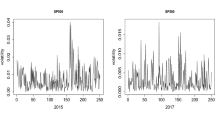Abstract
Earlier, a model of a time series with heavy tails constructed from a Gaussian time series was developed. In the present paper, the reverse problem is considered: an estimator of the copula function is built; the copula function is a nonlinear function that maps Gaussian variables to the variables from the Fréchet maximum domain of attraction. The statistical properties of this estimator are considered for a stationary time series with a low rate of covariance decay.
Similar content being viewed by others
References
H. Drees, “A general class of estimators of the extreme value index,” J. Stat. Plan. Infer., 66, No. 1, 95–112 (1998).
H. Drees, “On smooth statistical tail functionals,” Scand. J. Stat., 25, No. 1, 187–210 (1998).
H. Drees, “Weighted approximation of tail processes for β-mixing random variables,” Ann. Appl. Probab., 10, No. 4, 1274–1301 (2000).
H. Drees, “Tail empirical processes under mixing conditions,” in: Dehling H., Mikosch T., Sorensen M., eds., Empirical Process Techniques for Dependent Data, Birkhäuser, Boston (2002), pp. 325–342.
R. D. Gill, “Non- and semi-parametric maximum likelihood estimators and the von Mises method (part 1),” Scand. J. Stat., 16, No. 2, 97–128 (1989).
L. de Haan and A. Ferreira, Extreme Value Theory: An Introduction, Springer, New York (2007).
B. M. Hill, “A simple general approach to inference about the tail of a distribution,” Ann. Stat., 3, No. 5, 1163–1174 (1975).
M. R. Leadbetter, G. Lindgren, and H. Rootzén, Extremes and Related Properties of Random Sequences and Processes, Springer, New York (1983).
A. E. Mazur and V. I. Piterbarg, “Gaussian copula time series with heavy tails and strong time dependence,” Vestn. Mosk. Univ. Ser. 1 Mat. Mekh., 70, No. 5, 197–201 (2015).
V. I. Piterbarg, Asymptotic Methods in Theory of Gaussian Random Processes and Fields, Transl. Math. Monogr., Vol. 148, Amer. Math. Soc., Providence (2012).
V. I. Piterbarg, Twenty Lectures about Gaussian Processes, Atlantic Financial Press, London (2015).
H. Rootzén, “Weak convergence of the tail empirical process for dependent sequences,” Stoch. Processes Their Appl., 119, No. 2, 468–490 (2009).
Author information
Authors and Affiliations
Corresponding author
Additional information
Translated from Fundamentalnaya i Prikladnaya Matematika, Vol. 22, No. 3, pp. 127–144, 2018.
Rights and permissions
About this article
Cite this article
Mazur, A.E. Fitting Time Series with Heavy Tails and Strong Time Dependence. J Math Sci 254, 537–549 (2021). https://doi.org/10.1007/s10958-021-05324-3
Published:
Issue Date:
DOI: https://doi.org/10.1007/s10958-021-05324-3



